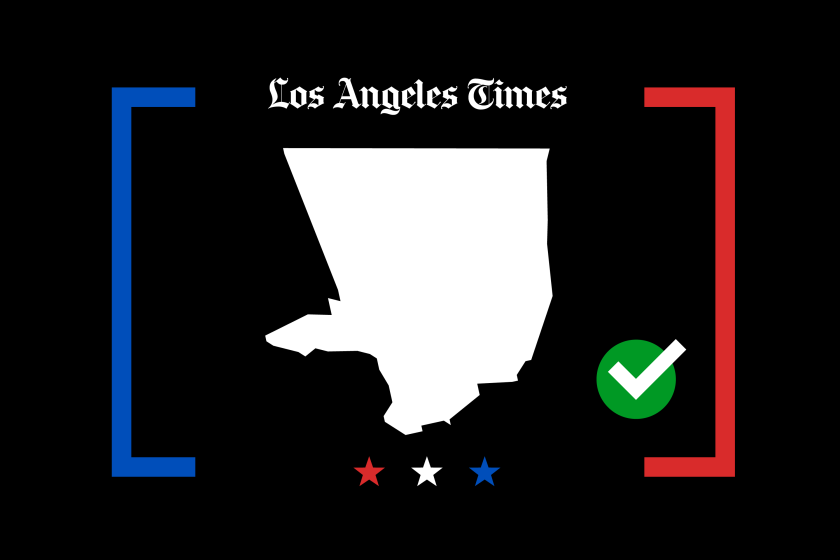Voters in car-centric L.A. approve Measure HLA to make room on streets for bikes, buses

- Share via
Backers of a citizen-sponsored ballot initiative that forces Los Angeles to add hundreds of miles of bike and bus lanes — to make streets safer for pedestrians and bicyclists — declared victory on Wednesday.
Measure HLA was leading by a wide margin, according to semifinal results released by the Los Angeles Registrar-Recorder/County Clerk on Wednesday.
“This says people in Los Angeles want change, they want safer streets, and they want the city to follow through on their promises,” said Michael Schneider, who has led the HLA campaign and is executive director of the advocacy group Streets for All, which conceived the measure.
Measure HLA requires Los Angeles to re-engineer some of the region’s most storied boulevards, reducing traffic lanes, building more space for bicyclists and buses, and providing better protections for pedestrians. It calls for 238 miles of protected bike lanes, hundreds more unprotected lanes and 300 miles of improvements for buses, including designated lanes and signal prioritization for public transit.
The transportation measure essentially compels the city to follow its nearly decade-old Mobility Plan 2035, which was meant to revamp how the city moved by designating specific roads for biking, transit and more foot traffic, but has been largely ignored.
When it was adopted in 2015, the plan marked a departure from how the city viewed street infrastructure that was largely created for cars to one that is multimodal. Transportation planners embraced the concept because such measures tended to make streets safer and reduce traffic speeds while encouraging transit, biking and walking.
“The city created a good plan that the voters are behind,” Schneider said. “City Council and city staff now have a mandate from voters to follow their own plan.”
Backers sank more than $3 million into HLA and the campaign largely centered on safety, erecting billboards across the city painting a dire picture of vehicle-caused deaths, which outpaced homicides last year.
“This is being watched nationally,” said Marlon Boarnet, director of the METRANS Transportation Consortium at USC. “It’s a signal across the country that people really value streets where, yes, they can drive, but they could also walk, they could also bicycle.”
Until now, Boarnet said, the narrative on so-called road diets in the region has often centered on those who oppose losing traffic lanes to bicyclists or buses. He pointed to places such as Culver City, where the council pared back its plan to eliminate car lanes after an outcry. And in Los Angeles, KeepLAMoving, a top opponent of HLA, helped beat back earlier efforts to reduce car lanes, scoring a victory in 2017 when officials removed bike lanes on the Westside.
“The fight to bring back some common sense to street planning in Los Angeles is not over,” said Christopher LeGras, co-director of KeepLAMoving. He contended that traffic would increase and that local businesses would probably lose parking, and said that the plan lacked a component for community input. The group will continue organizing opposition and is looking at options to slow or stop the measure, he said.
Under HLA, each time city agencies pave or improve one-eighth of a mile (660 feet) of street, they must install elements of its Mobility Plan. And the city must track their progress for the public to see online. If the city doesn’t comply, residents can sue.
The campaign gained the support of half a dozen City Council members, business groups and unions. It faced little financially backed opposition until a month ago, when the city’s firefighters union weighed in against it.
United Firefighters of Los Angeles City Local 112, which represents about 3,400 firefighters, said it spent $250,000 to defeat the measure.
Backers of Measure HLA, which would add new bike and bus lanes across the city, denounced the report, calling it ‘last-minute electioneering.’
“It’s unfortunate,” union President Freddy Escobar said. “We got outspent.”
Escobar said the failure of many city leaders to take a stand against the only city measure on the ballot hurt the campaign. Although seven City Council members backed the measure, two of the most powerful elected officials at City Hall — Mayor Karen Bass and Council President Paul Krekorian — did not take a position.
“We knew it was going to be an uphill battle,” he said. “I wish others would have stood with us.”
“And now, unfortunately, the residents of Los Angeles will realize what we have been saying that it’s going to delay response times and not going to help with the traffic.”
City Administrative Officer Matt Szabo released a report a day after the firefighters came out against the plan warning that Measure HLA projects would cost the city $3.1 billion over a decade and would force difficult budget choices in the coming years. Schneider and supporters have said Szabo’s estimates are inflated. Based on similar city projects, he estimates the measure would cost $28.6 million a year over a decade.
Szabo has said that the financial strain could force the city to delay other pavement projects. And some transit advocates worry that the plan does not take into account community needs. There is nothing in the plan that guides how it is implemented and whether neighborhoods with greater needs are prioritized.
More to Read
Get the L.A. Times Politics newsletter
Deeply reported insights into legislation, politics and policy from Sacramento, Washington and beyond. In your inbox twice per week.
You may occasionally receive promotional content from the Los Angeles Times.












